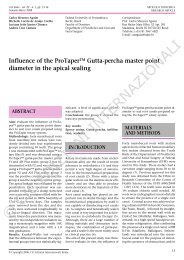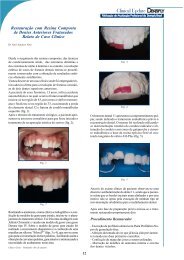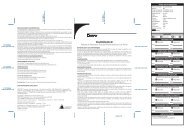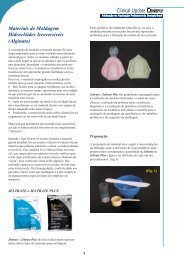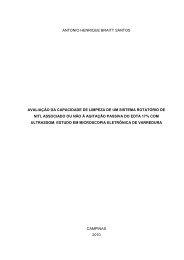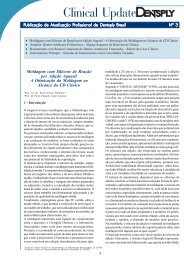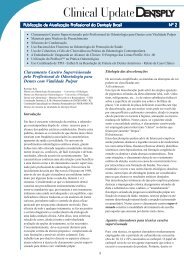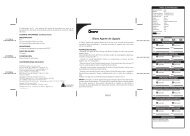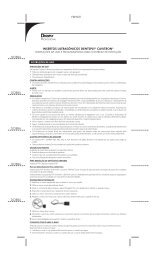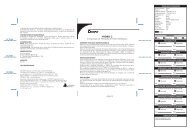You also want an ePaper? Increase the reach of your titles
YUMPU automatically turns print PDFs into web optimized ePapers that Google loves.
XP BOND in Self-curing mode used for Luting Porcelain<br />
Restorations. Part B: Placement and 6-month Report<br />
Marco Ferrari a /Ornella Raffaelli b /Maria Crysanti Cagidiaco c /Simone Grandini d<br />
Purpose: The aim of this clinical study was to evaluate the postoperative sensitivity of Empress II restorations luted under<br />
clinical conditions with XP BOND in combination with SCA and Calibra cured in self-curing mode.<br />
Materials and Methods: Fifty-three restorations were placed in 38 patients in March and April 2006. No patient received<br />
more than two restorations. Luting procedures were performed following manufacturers’ instructions. The restorations<br />
were evaluated after 2 weeks and 6 months for postoperative sensitivity, marginal discoloration, marginal integrity, secondary<br />
caries, maintenance of interproximal contact, and fracture.<br />
Results: At the 2-week recall, the postoperative sensitivity was reported in only 10 and after 6 months in only 3 patients.<br />
All other parameters showed alpha scores.<br />
Conclusion: All the evaluated restorations were in place and acceptable. The postoperative sensitivity recorded after<br />
using XP BOND and Calibra in self-curing mode was clinically acceptable.<br />
Keywords: ceramic crowns, self-curing, clinical trial, bonding.<br />
J Adhes Dent 2007; 9: 279-282. Submitted for publication: 15.12.06; accepted for publication: 11.1.07.<br />
Indirect ceramic restorations are a valid alternative to direct<br />
esthetic restorations and to porcelain-fused-to-metal<br />
crowns. The prerequisite for application of full and/or partial<br />
porcelain crowns is perfect bonding, which has to integrate<br />
all parts into one coherent structure. 6 Therefore, luting material<br />
and technique as well as the substrate characteristics<br />
represent the factors determining success. 7<br />
a Dean, Professor, and Chair, Department of Dental Materials and Prosthodontics,<br />
University of Siena, Siena, Italy.<br />
b PhD Student, Department of Dental Materials and Prosthodontics, University<br />
of Siena, Siena, Italy.<br />
c Assistent Professor, Department of Dental Materials and Prosthodontics, University<br />
of Siena, Siena, Italy.<br />
d Chair, Assistent Professor, Department of Endodontics, University of Siena,<br />
Siena, Italy.<br />
Paper presented at Satellite Symposium on Dental Adhesives, Dublin,<br />
September 13th, 2006<br />
Reprint requests: Prof. Marco Ferrari, Research Center for Dental Health, 19<br />
Piazza Attias, 57120 Livorno, Italy. Tel: +39-586-892-283, Fax: +39-586-898-<br />
305. e-mail: ferrarimar@unisi.it<br />
Different combinations of adhesive luting materials have<br />
been tested, and dual-curing bonding systems are often the<br />
first choice. 3,5,8,12,14-16,18,19,21 Dual-curing bonding agents<br />
permit polymerization of the adhesive materials and the<br />
resin cement underneath a thick ceramic restoration. Recently,<br />
XP BOND (<strong>Dentsply</strong> DeTrey; Konstanz, Germany) was<br />
proposed and tested experimentally, showing interesting data<br />
when the adhesive was used in self-curing mode. 20<br />
Postoperative sensitivity is a common complication when<br />
porcelain crowns are luted on vital teeth. 9 The aim of the present<br />
prospective clinical trial was to evaluate the early postoperative<br />
sensitivity of Empress II restorations (Ivoclar-Vivadent;<br />
Schaan, Liechtenstein), cemented under clinical<br />
conditions with the adhesive system XP BOND/SCA and Calibra<br />
resin cement (<strong>Dentsply</strong> Caulk; Milford, DE, USA), both<br />
used in self-curing mode.<br />
MATERIALS AND METHODS<br />
The sample consisted of 53 consecutively placed restorations<br />
in 38 patients in need of one or two single units. Par-<br />
Vol 9, Supplement 2, 2007 279



